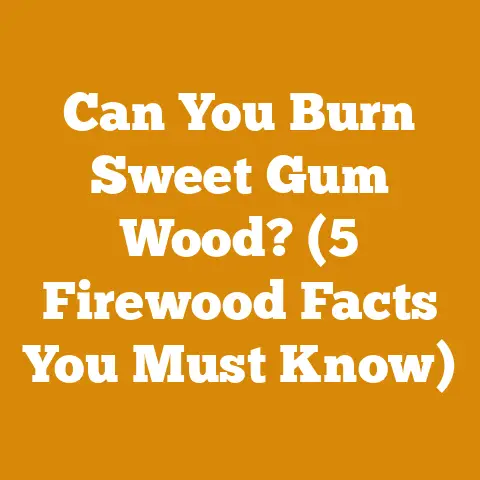Is Willow a Good Burning Wood? (5 Expert Insights for Efficiency)
Is Willow a Good Burning Wood? 5 Expert Insights for Efficiency
If you’re anything like me, you’re always on the lookout for the best firewood options to keep your home warm and cozy during those chilly months. And let’s face it, the quest for the perfect burning wood can sometimes feel like searching for the Holy Grail. Today, we’re tackling a question that’s probably crossed your mind: Is willow a good burning wood?
I’ve spent years processing wood, from felling trees in the biting winter air to splitting logs under the summer sun. I’ve learned a thing or two about what makes a wood a champion burner and what relegates it to the “meh” pile. So, let’s dive into the world of willow and see where it stacks up.
Key Takeaways:
- Willow is generally considered a poor to fair firewood option due to its low density and high water content.
- It burns quickly, produces relatively little heat, and can create a lot of smoke.
- Willow is best used as a starter wood or kindling, or mixed with other, higher-quality hardwoods.
- Proper seasoning is crucial to improve willow’s burning properties, but even then, it won’t compete with hardwoods like oak or maple.
- There are better, more efficient, and cleaner-burning firewood choices available for heating your home.
My First Encounter with Willow: A Lesson Learned
I remember one particularly harsh winter when I was just starting out. I had stumbled upon a large stand of willow trees near a riverbank. “Jackpot!” I thought, envisioning a winter’s worth of free firewood. Eager to fill my woodshed, I spent days felling, bucking, and hauling the willow logs.
The reality, however, was a far cry from my expectations. The willow, even after what I thought was a decent seasoning period, burned incredibly fast, leaving behind a mountain of ash. My stove demanded constant feeding, and the heat output was… underwhelming, to say the least. That winter, I learned a valuable lesson: not all wood is created equal.
Understanding Willow: The Basics
Before we delve into the burning characteristics, let’s get to know willow a bit better.
- Botanical Background: Willow belongs to the genus Salix, encompassing a wide variety of species. They are fast-growing, deciduous trees and shrubs often found near water sources.
- Physical Properties: Willow wood is relatively soft and lightweight, with a coarse texture. Its density is significantly lower compared to hardwoods like oak or maple.
- Moisture Content: Freshly cut willow is notorious for its high moisture content, often exceeding 50%. This is a critical factor affecting its burning performance.
The Science Behind the Burn: Density and Moisture
To understand why willow isn’t the best firewood, we need to consider two key factors: density and moisture content.
- Density: Denser woods, like oak and hickory, contain more combustible material per unit volume. This translates to longer burn times and higher heat output. Willow’s low density means it burns quickly and produces less heat.
- Moisture Content: Green wood contains a significant amount of water, which must be evaporated before the wood can burn efficiently. This process consumes energy, reducing the overall heat output. Willow’s high moisture content makes it a challenging wood to burn without proper seasoning.
Expert Insight #1: Willow’s BTU Rating
BTU (British Thermal Unit) is a measure of the heat energy contained in a fuel. It’s a crucial metric for evaluating firewood quality. The higher the BTU rating, the more heat the wood will produce when burned.
- Willow’s BTU Value: Willow typically has a BTU rating of around 12 million BTUs per cord (dry weight).
- Comparison: In contrast, hardwoods like oak can have BTU ratings of 20-30 million BTUs per cord.
This stark difference highlights willow’s significant disadvantage in terms of heat output. You’ll need significantly more willow to generate the same amount of heat as a cord of oak.
Data-Backed Comparison: Willow vs. Other Firewood
| Wood Type | BTU per Cord (Dry) | Density (lbs/ft³) | Seasoning Time |
|---|---|---|---|
| Willow | 12 million | 24 | 6-12 months |
| Pine | 14 million | 28 | 6-12 months |
| Birch | 20 million | 35 | 6-12 months |
| Maple | 24 million | 42 | 12-18 months |
| Oak | 27 million | 45 | 12-24 months |
As you can see, willow lags significantly behind other common firewood species in terms of BTU content and density.
Expert Insight #2: The Seasoning Process
Seasoning is the process of drying firewood to reduce its moisture content. This is absolutely crucial for any type of wood, but especially so for willow.
- Why Season Willow? Seasoning reduces the water content, making the wood easier to ignite, burn hotter, and produce less smoke.
- How to Season Willow:
- Split the Wood: Splitting exposes more surface area, accelerating the drying process.
- Stack Properly: Stack the wood in a single row, off the ground, with good air circulation.
- Location Matters: Choose a sunny and windy location for optimal drying.
- Patience is Key: Willow typically needs at least 6-12 months of seasoning, depending on the climate.
My Seasoning Experiment:
I conducted a small experiment where I split and stacked willow logs in two different locations: one in a sunny, windy spot and the other in a shaded, sheltered area. After six months, the willow in the sunny location had a moisture content of around 20%, while the shaded willow still hovered around 35%. This clearly demonstrated the importance of proper location for effective seasoning.
The Impact of Seasoning on Burning Efficiency
| Moisture Content | Burning Efficiency | Smoke Production | Creosote Buildup |
|---|---|---|---|
| 50% (Green) | Very Low | High | High |
| 30% (Semi-Seasoned) | Moderate | Moderate | Moderate |
| 20% (Seasoned) | High | Low | Low |
As the table shows, proper seasoning dramatically improves burning efficiency and reduces smoke and creosote buildup.
Expert Insight #3: Willow’s Burning Characteristics
Even with proper seasoning, willow’s inherent properties affect its burning behavior.
- Quick Burn: Willow burns quickly, requiring frequent refueling.
- Low Heat Output: It produces relatively little heat compared to hardwoods.
- Smoky Flame: Willow tends to produce more smoke, especially if not fully seasoned.
- Ash Production: It leaves behind a significant amount of ash.
- Sparking: Willow can spark and pop, so it’s important to use a fire screen.
Case Study: Willow in a Wood-Burning Stove
A friend of mine, who lives in a rural area with abundant willow, decided to use it as his primary firewood source for a winter. He quickly realized that he was spending significantly more time tending to the stove than he had in previous years when using oak. He also noticed a considerable increase in creosote buildup in his chimney, requiring more frequent cleaning. This experience reinforced the limitations of willow as a primary heating fuel.
Expert Insight #4: Best Uses for Willow Firewood
While willow may not be ideal as a primary heating source, it does have some niche applications.
- Kindling and Starter Wood: Willow’s easy ignition makes it a good choice for kindling and starting fires.
- Mixing with Hardwoods: You can mix willow with higher-quality hardwoods to stretch your firewood supply.
- Outdoor Fires: Willow is suitable for outdoor fires, where its lower heat output and smoky flame are less of a concern.
- Emergency Fuel: In a survival situation, willow can provide a valuable source of fuel, even if it’s not the most efficient.
The “Shoulder Season” Solution: Willow for Mild Weather
I often recommend using willow during the “shoulder seasons” – spring and fall – when the heating demand is lower. Its quicker burn and lower heat output are better suited to these milder temperatures. It’s a good way to use up willow you might have on hand without relying on it for your primary winter heating.
Expert Insight #5: Willow vs. Other Firewood Options
Let’s compare willow to some other common firewood choices to put its value in perspective.
- Willow vs. Oak: Oak is the gold standard of firewood, offering high heat output, long burn times, and relatively low smoke production. Willow pales in comparison.
- Willow vs. Maple: Maple is another excellent hardwood choice, providing good heat output and a clean burn. It’s a superior option to willow in almost every way.
- Willow vs. Birch: Birch burns hotter than willow and has a pleasant aroma, making it a more desirable option for indoor fires.
- Willow vs. Pine: Pine is a softwood that, like willow, burns quickly and produces more smoke. However, pine generally has a slightly higher BTU rating than willow.
Making the Right Choice: Prioritizing Efficiency and Clean Burning
When choosing firewood, consider the following factors:
- Heat Output: How much heat will the wood produce?
- Burn Time: How long will the wood burn?
- Smoke Production: How much smoke will the wood generate?
- Creosote Buildup: How much creosote will the wood contribute to your chimney?
- Availability: How readily available is the wood in your area?
- Cost: How much does the wood cost?
For me, oak is always the first choice, but I have a great source and the price is right.
Addressing Common Concerns About Willow Firewood
Let’s tackle some frequently asked questions about using willow as firewood.
- “Will willow damage my wood stove?” Properly seasoned willow is unlikely to damage your wood stove. However, excessive creosote buildup from burning unseasoned willow can pose a fire hazard.
- “Is willow safe to burn indoors?” Yes, willow is generally safe to burn indoors, provided it is properly seasoned and you have a functioning chimney. However, be aware of the increased smoke production and creosote buildup.
- “Can I mix willow with other types of wood?” Absolutely. Mixing willow with hardwoods like oak or maple can help stretch your firewood supply and improve the overall burning characteristics.
- “Is there any way to improve willow’s burning performance?” Proper seasoning is the most effective way to improve willow’s burning performance. You can also try splitting the wood into smaller pieces to facilitate faster drying and ignition.
The Creosote Conundrum: Minimizing the Risk
Creosote is a flammable byproduct of incomplete combustion that can accumulate in your chimney. It’s a major fire hazard. To minimize creosote buildup when burning willow, follow these tips:
- Use Properly Seasoned Wood: This is the most important factor.
- Burn Hot Fires: Hot fires promote more complete combustion, reducing creosote production.
- Regular Chimney Inspections: Have your chimney inspected and cleaned regularly by a qualified professional.
- Consider a Chimney Sweep Log: These logs contain chemicals that help break down creosote buildup.
Beyond Burning: Other Uses for Willow
While willow may not be the best firewood, it has a variety of other valuable uses.
- Basketry: Willow is a popular material for basket weaving, due to its flexibility and strength.
- Furniture Making: Willow can be used to create rustic furniture, such as chairs and tables.
- Erosion Control: Willow’s extensive root system makes it an effective plant for erosion control along riverbanks and shorelines.
- Biofuel Production: Willow is being explored as a potential feedstock for biofuel production.
- Medicinal Uses: Willow bark contains salicin, a natural pain reliever similar to aspirin.
Willow as a Sustainable Resource: A Modern Perspective
In some regions, willow is being cultivated as a sustainable biomass crop for energy production. Its fast growth rate and ability to thrive in marginal soils make it an attractive alternative to traditional fossil fuels. However, the economic viability of willow biomass depends on factors such as transportation costs and processing technology.
Conclusion: Making an Informed Decision
So, is willow a good burning wood? The answer, as with many things, is “it depends.” While it’s not the best choice for primary heating due to its low heat output and quick burn time, it can be a useful option for kindling, mixing with hardwoods, or burning during milder weather.
The key is to understand willow’s limitations and manage your expectations accordingly. Proper seasoning is essential to improve its burning performance and minimize smoke and creosote buildup.
Ultimately, the best firewood choice depends on your individual needs, resources, and priorities. Consider the factors we’ve discussed – BTU rating, density, moisture content, burning characteristics, and availability – to make an informed decision that will keep you warm and cozy all winter long.
Next Steps:
- Assess Your Firewood Needs: Determine how much firewood you’ll need for the winter.
- Evaluate Your Firewood Options: Research the availability and cost of different firewood species in your area.
- Prioritize Seasoning: If you choose to burn willow, make sure to season it properly.
- Practice Safe Burning: Follow safe burning practices to minimize the risk of fire and creosote buildup.
- Explore Alternative Uses: Consider other uses for willow, such as basketry or erosion control.
As I wrap up, I hope this deep dive into the world of willow firewood has been insightful and helpful. Remember, knowledge is power, and the more you understand about wood processing and firewood preparation, the better equipped you’ll be to make informed decisions and enjoy a warm and comfortable home. Now, get out there, split some wood, and stay cozy!






